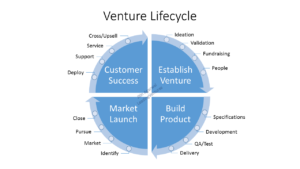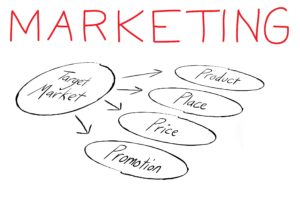I’ve had many requests from entrepreneurs and others in the venture world asking if there was a clearly articulated venture lifecycle document or diagram. They were all looking for something that cleanly lays out all of the major steps in a venture’s lifecycle – from creation to customers.
After looking all over the place and not finding what I was looking for, I decided to go ahead and create my own venture lifecycle framework to serve as a tool for reference. This blog covers each of the 4 main areas of my venture lifecycle framework and briefly covers the sub-topics in each category in the lifecycle.

The Four Stages of a Venture Lifecycle
The four stages of the venture lifecycle in order are Establish Venture, Build Product, Market Launch and Customer Success. These represent the 4 major milestones in the life of a venture.
1. Establish Venture
This first phase represents the stage where the venture may not even be formally conceived of or it may just be a concept. This stage takes the venture from concept to an actual reality of people working towards the goals and aspirations established for the venture.
We begin with the Ideation stage. This is the process by which the central “idea” for a product or service occurs to a founder or founding team that results in the seed around which the venture is built. For more in-depth information on this topic, check out my previous blog Choosing Your Next Venture — Three Key Steps to Success.
Next comes Validation, where that initial idea is “kicked-around” by various people, in different ways, from a variety of angles. The purpose of this stage is to “harden” the idea by exposing it to as many “pressures” as possible. This will ultimately strengthen it or destroy it. If the original idea is scrapped, often times a new better idea emerges from the ashes like a phoenix. You can read more about this topic in my blog entitled – How to Decide What Product to Bring to Market
Now, the Fundraising stage begins. Without the cash to help take your idea to the next level, many ideas will remain great ideas that no one ever executed upon. That’s why fundraising is so critical. The good news is that in this day and age, fundraising is somewhat easier to obtain than it was 10-20 years ago. I’ve covered this topic in a couple of blogs – you can find them here and here.
The last part of the Establish Venture phase is People. At the end of the day, every venture is all about execution and your people will drive the execution and deliver those results. Without the right people your venture isn’t going to be able to achieve the grand dreams, goals and aspirations you have for it. Hence this is the last, and perhaps the most critical step in establishing your venture – finding, recruiting and hiring the right people.

2. Build Product
This stage represents the “heavy lifting” portion of the venture’s lifecycle. It’s where the team takes the kernel of an idea and transforms it into something that customers can see, touch, feel and interact with. If this stage is executed successfully, it sets the venture up for success. Failure here could force the team to pivot or could spell failure for the venture.
The first step in building a product is the Specification stage. This is where the needs or requirements are defined. I am not altogether comfortable with the term requirements because I think it’s too constraining and implies that all of those potential features/functions must be built. Decisions to reduce “must-haves” are sometimes required on the road to market as time becomes critical. It is important to pull together information, insights, features and functions that will make the product stand out in the market. That will require an appropriate level of functionality as compared to your competitors and also something unique that you are offering that separates your product from the crowd.
The next step in this phase of the venture lifecycle is Development of the product. This is the actual coding and creation of the product. This may include any and all of the steps and processes required to actually build the product; whether you are creating UX, UI, code, back-end, front-end, or whatever other elements play into building the product. In addition to coding, this phase may include the infrastructure to build the product and other aspects of product development.
After that, the verification or validation of the product occurs. This is also known as QA/Test (Quality Assurance). A solid QA process and validation steps will ensure that your product is a success out there in the market. A poor effort here can result in buggy, defective products that fail in the market. Think about your QA folks as the voice of the customer in the Build Products phase.
The final step in this phase is the Delivery component. This encompasses all of the items necessary to push your product out to market. This could be a cloud infrastructure or it might include the payment mechanism to charge for your product. This stage includes all of the items necessary to effectively deliver the product into the customer’s hands and represents the final “sign off” of the product from the product team.

3. Market Launch
This is the stage that often gets the most attention and visibility – because this is the stage when the rest of the world typically gets to see and interact with your product. This is the stage where it is taken out and showcased to the world at large.
The first step in this phase is to Identify the target market for the product. Who will want to buy it and why? What’s the process to buy it and who has the power? How much will it cost and why would they pay that price? All these questions and more are part of the process to understand how the venture can capture the attention of potential customers as it enters the market. Some aspects of identifying the customer are covered in the initial evaluation phase in the Establish Venture phase, but this step will yield a much deeper, broader and richer understanding of the customer, their needs and the value proposition for the product to satisfy the customer’s needs.
The second step in this phase is to Market the product. This involves all aspects of marketing the product in the world – at – large. In this day and age that involves a healthy dose of social media marketing and other unconventional channels. The key here is to get the message out about your product to your target audience to entice them to adopt or buy your product.
The third part of this phase is called Pursue. This is where the venture engages in a pursuit of the identified customers with the product and channels of communication. It’s not enough to have a great product, you have to get the message out in the right places and you have to woo the customers to win them over. Engaging and winning over prospective customers is a critical part of the sales process.
The final part of the market launch phase is Close. These are all of the steps that are needed to finalize the deal with the prospect and make them into an official customer. In some simple cases this may be as quick as checking the I Accept box on a form and clicking the Submit button – enabling the download and installation of the product. Or it could be a much more complicated process involving contracts, agreements and other legal documents. Either way closing the deal is the final step in the market launch phase.
4. Customer Success
This is the final phase in the venture lifecycle. It may seem odd that this is last because this is the entire reason that the venture was founded and created its products and decided to take them to market. Rest assured that this is the proper order and this critical step that has been considered since from Day 1 when we were establishing our venture, while we were building the product and during the marketing phase. When customers use your products and enjoy them or become more successful (save money, time or materials), they will recommend you and help you build your reputation in the marketplace.
The first step in the customer success is to Deploy the product for the customer; sometimes this step is also called implementation. The meaning of deployment varies from customer to customer and product to product. For some it can be as simple as a double-click download and install. While for others it can be a multifaceted process that starts with requirement gathering and ends with a deployment to an array of on premise servers in the client’s data-center. Regardless of the process the first step is to successfully deploy the product for the customer.
The second step in this phase after deployment is to Support the customer. This requires the venture to help the customer get up and running on the product. Again, this process varies. In some cases, it can be as simple as a tutorial that is kicked off when the app first starts, like in many games. In other cases, it can be a fairly lengthy process involving in-person or remote training of worldwide associates. Either way, the key activity here is to ensure that the customer is supported.
The third part of this phase is Service. Think of this as beyond simple training and day to day support. The biggest metric for success of this phase is adoption of the product or service. Often service requires the venture to go beyond what might have been envisioned by the customer or the venture at the point of purchase. In fact, if service is achieving a level of value-add and contribution observed by the customer, by extending the scope and expectations of the product after purchase, then it is succeeding. This can be achieved by finding new use cases and groups who can benefit from the utilization of the product. To paraphrase Star Trek – the mission of service is to go where “no one has gone before” with the product.
The fourth and final aspect of Customer Success is Cross/Upselling. A successful service phase is necessary precursor for this stage. Insights, use cases and client needs gleaned from the service phase feed directly into and create exposure to opportunities to cross or upsell new products, features, functions or capabilities of the venture to your existing customers. Often ventures are off to the races chasing the “next big thing” and they forget that they can continue to successfully and very profitably build their business by anticipating current customer demands and wishes. If you follow the “land and expand” model of extending your business, don’t forget to expand! Remember that it’s much easier to cultivate from your best customers with new capabilities, products and features than woo new ones. Think of it as deepening your relationship with your customers by becoming an indispensable part of their business – one that they won’t want to or ever need to replace.
Once the venture completes one iteration of this lifecycle, the model is quite simple; as it says on the back of the shampoo bottle – rinse and repeat. The venture needs to reinitiate the venture lifecycle process by cultivating new ideas to expand its business. Evaluate those ideas, fund and staff them. Then develop them, launch them into market, successfully deliver for those customers and then rinse and repeat. A venture that can continually and successfully execute on this model, more than once – is the hallmark of a truly successful and enduring venture – one that VCs and other investors will readily want to fund and underwrite.
Do you have a question or a topic to suggest? Want to get another perspective on an issue or challenge you’re facing? I welcome your comments, questions, feedback and insights below or feel free to email me directly here. Please read and share all my blogs at LeadingVentures.com.
About this blog – The goal of this blog is to share my experiences, to capture and reveal valuable insights, and to draw from my serial entrepreneur-ship through 7 ventures over the past 20 years. I have encountered many impressive entrepreneurs along the way and I hope to share our collective experience with you to help teach and perhaps motivate you to launch your own B2B or B2C enterprise.
© Jitin Agarwal – All rights reserved. This blog is property of Jitin Agarwal and leadingventures.com. Unauthorized use and/or duplication of this material without express and written permission from this site’s author and/or owner is strictly prohibited. Excerpts and links may be used, provided that full and clear credit is given to Jitin Agarwal and leadingventures.com with appropriate and specific direction to the original content. For this blog, in instances where other previously copyrighted content, trademarks or brand references are used and noted as such, the author disavows any ownership claim, trademark, copyright or intellectual property ownership of these items and they remain the property of their respective and original owners, their inclusion in this blog is merely for illustrative example purposes only.





Jitin ji,
Great Article. Very well presented and great inputs
I am also sharing this at BPOP Group for Best Practices at Linkedin
Regards
Ajaya
Ajaya,
Thanks for your positive feedback. Apologies on the delayed response. Candidly I didn’t ever expect anyone to ever comment on any of my blog posts – so only recently realized that I had nearly a dozen comments to respond back to. 🙂
Regards
Jit